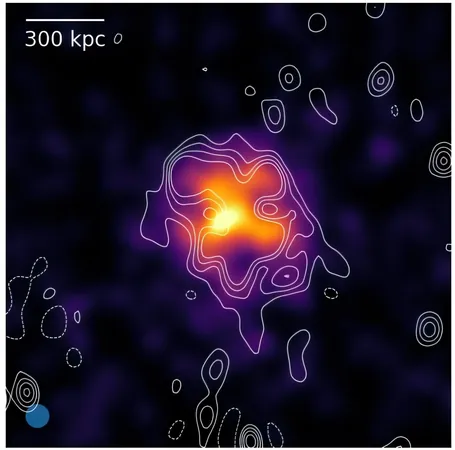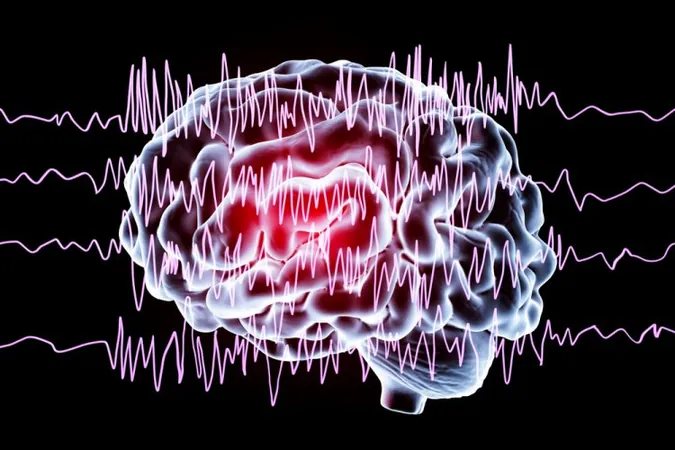
Astronomers Unveil Stunning New Radio Halo in Distant Galaxy Cluster!
2025-09-17
Author: Yu
A Groundbreaking Discovery with the MeerKAT Telescope!
In a remarkable astronomical breakthrough, a team of international scientists utilizing the cutting-edge MeerKAT radio telescope has uncovered a fascinating ultra-steep spectrum radio halo within the galaxy cluster SPT-CLJ2337-5942. Their astonishing findings were unveiled in a paper released on September 9, showcasing the unseen mysteries of our universe.
What are Radio Halos and Why Do They Matter?
Radio halos are massive, diffuse regions of radio emissions typically located in the cores of large galaxy clusters and reveal the dynamics of the turbulent intracluster medium (ICM). However, detecting these enigmatic structures is no easy feat due to their incredibly low brightness at higher frequencies, which makes them elusive until observed at lower frequencies.
Shining a Light on Ultra-Steep Spectrum Radio Halos!
Among these intriguing halos is the ultra-steep spectrum radio halo (USSRH), formed through chaotic particle acceleration. Identifying new USSRHs provides critical insights into the mechanisms behind particle re-acceleration and the effects of cluster mergers.
The Discovery of a New USSRH!
Under the leadership of Isaac S. Magolego from the University of the Witwatersrand, the research team systematically combed through a sample of 89 SPTpol galaxy clusters within a 100 square degree field from MeerKAT. To their excitement, they confidently detected a new USSRH at the center of SPT-CLJ2337-5942.
A Massive Discovery!
The MeerKAT's UHF-band imaging revealed a sprawling emission stretching roughly 2.6 million light years at 816 MHz, showcasing complex structures that signal the vigorous activities within this cluster. The spectral analysis showed that this radio halo possesses an integrated spectral index of 1.76, significantly steeper than theoretical predictions, indicating ongoing particle re-acceleration.
A Window into the Universe’s Mysteries!
The research unveiled a remarkable correlation between the halo's diffuse emissions and X-ray brightness, underscoring a direct connection between thermal ICM electrons, non-thermal components, and the magnetic fields prevalent in clusters.
The Next Frontier for Cosmic Exploration!
This groundbreaking radio halo represents the highest redshift USSRH discovered to date, offering pivotal clues for enhancing our understanding of radio halo formation. Looking ahead, the astronomers anticipate that upcoming observations with the Square Kilometre Array (SKA) and continued low-frequency surveys like MeerKAT-SPT will unveil even more high-redshift USSRHs, expanding our knowledge of the cosmos!


 Brasil (PT)
Brasil (PT)
 Canada (EN)
Canada (EN)
 Chile (ES)
Chile (ES)
 Česko (CS)
Česko (CS)
 대한민국 (KO)
대한민국 (KO)
 España (ES)
España (ES)
 France (FR)
France (FR)
 Hong Kong (EN)
Hong Kong (EN)
 Italia (IT)
Italia (IT)
 日本 (JA)
日本 (JA)
 Magyarország (HU)
Magyarország (HU)
 Norge (NO)
Norge (NO)
 Polska (PL)
Polska (PL)
 Schweiz (DE)
Schweiz (DE)
 Singapore (EN)
Singapore (EN)
 Sverige (SV)
Sverige (SV)
 Suomi (FI)
Suomi (FI)
 Türkiye (TR)
Türkiye (TR)
 الإمارات العربية المتحدة (AR)
الإمارات العربية المتحدة (AR)